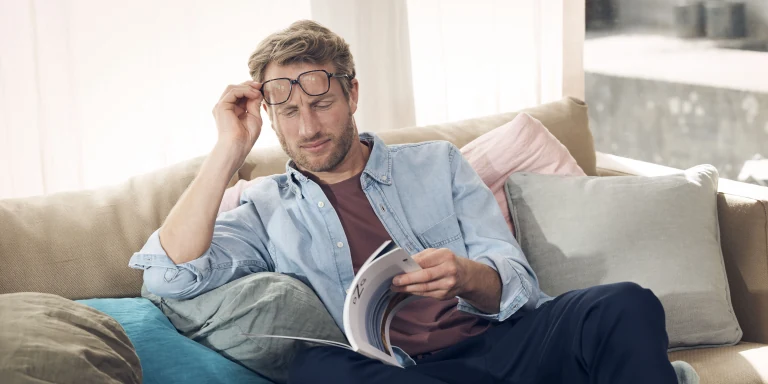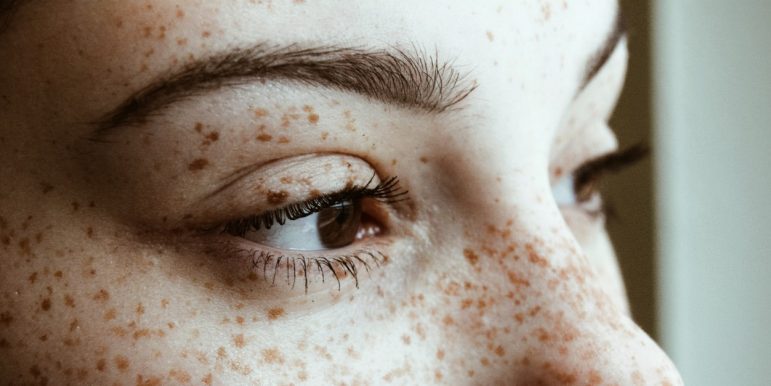
Short-sighted or long-sighted – what’s the difference?
Four out of five Swiss citizens suffer from some form of weak vision. How does short- and long-sightedness occur? And what can you do about it?
The majority of Swiss people are dependent on visual aids. According to surveys conducted by Optik Schweiz, the Swiss association for optometry and optics, 80 percent of all 16- to 74-year-olds in Switzerland wear glasses or contact lenses. This rate is higher than in previous surveys. However, this doesn’t mean our vision is getting worse. In the past, mild refractive defects in our eyes were often simply went unnoticed and therefore uncorrected. Demographic trends are also having an impact on increasing numbers: the population is getting older, and as we age, short visual acuity tends to decline.
An overview of defective vision
Short-sightedness
How is short-sightedness defined?
Short-sightedness, or myopia in technical terms, is a congenital or acquired type of defective vision in the eye. Short-sighted people see more distant objects indistinctly and blurred, but recognise objects that are close by without any problems. Myopia is measured with negative dioptres. From a value of -0.5 dioptres a correction can be useful, but from -1.0 it is necessary.
How does short-sightedness develop?
The length of the eye is congenital, but may change over the years as it grows. Basically, there are two causes of short-sightedness:
- The eyeball is slightly too long (axial myopia)
- The lens and cornea refract light too strongly (refractive myopia)
A combination of axial and refractive myopia is also possible. If either of these causes is present, the light rays are focused in front of the retina instead of on the retina, as would be the case in a healthy eye. The result: we see a blurry image. Short-sightedness is often inherited. If both parents are short-sighted, in 60 percent of cases, their children are also affected. If myopia is not congenital, excessive proximity work or artificial light can affect our vision: not only reading books and newspapers, but, more recently, the intensive use of smartphones, tablets and other screens can lead to myopia.
What are the consequences of short-sightedness?
Short-sightedness is increasing worldwide. However, according to a recent study, short-sightedness not only progresses significantly in children, as previously thought, but also in adults between the ages of 20 and 30. As a rule, short-sightedness can be easily corrected with a visual aid, i.e. glasses or contact lenses.
A dioptre of -6 or more is called pathological myopia. The consequences:
- Due to the eye being severely elongated, the retina and choroid can be stretched to the point that it can result in a severely thinned retina.
- There is an increased risk of retinal detachment or macular disease such as cataracts or glaucoma. Typical symptoms of retinal detachment: seeing flashes, shadows and what can be described as sooty rain (the appearance of black dots and spots in the field of view)
How do you treat short-sightedness?
With a suitable visual aid, the amount of light in front of the eye can be controlled so that what is seen is no longer displayed in front of the retina but exactly onto it.
Glasses: Short-sightedness is corrected with a diverging lens. It shifts the point at which distant objects come into focus so that they are no longer in front of the retina, but directly on it. Minus lenses are slightly thicker at the edge than in the centre, but can be ground very thin thanks to modern technology.
Contact lenses: Contact lenses work according to the same principle as eyeglasses. They allow for optimal visual acuity even in cases of severe myopia. If the eye is suitable for contact lenses and care instructions and regular check-ups are followed, contact lenses can be worn for a long time without any problems. However, you should not wear contact lenses permanently, but alternate corrective lenses with suitable glasses.
Laser treatment: Today, short-sightedness can also be corrected with modern laser eye surgery. Different types of treatments are available. During laser treatment, the cornea is permanently flattened so that the specific type of defective vision is corrected. If a patient also has an astigmatism (curvature of the cornea), this can be treated at the same time.
Just forty minutes of daily exercise in the fresh air can help prevent primary school-aged children from short-sightedness. This is the result of a Chinese study that investigated the relationship between outdoor activity and short-sightedness in children. Always watching TV and looking at computer and smartphone screens close up – and the lack of natural light – are major factors in the development of short-sightedness. This is why parents are strongly advised to encourage their children to play outside in daylight as much as possible. Australian researchers are now researching whether spending time outdoors can also have a positive effect on short-sightedness in adults.
Long-sightedness
How is long-sightedness defined?
Long-sightedness is also called hyperopia or hypermetropia and results in you being able to see things in the distance well, but not being able to see small print or close objects sharply. However, hyperopia should not be confused with presbyopia. Hyperopia is measured with positive dioptres. For most people, the refractive power of their eyes is less than +4 to +5 dioptres.
How does long-sightedness develop?
In a long-sighted eye, the focal point of the light does not lie exactly on the retina, but behind it. The following causes could be responsible for the condition:
- The eyeball is slightly shorter than normal (axial hyperopia).
- In rare cases, the lens and cornea cannot refract light strongly enough (refractive hyperopia)
Depending on age and the degree of long-sightedness, distant objects are perceived more sharply than objects that are close by. The severity of long-sightedness rarely changes with age – in comparison to short-sightedness.
What are the consequences of long-sightedness?
Often, long-sightedness is not even recognised at a young age. This is because the visual system can still easily be balanced out. However, this is achieved by an increased, albeit unnoticed, strain on the eyes. However, with more pronounced hyperopia or with increasing age, this exertion can trigger various kinds of physical discomfort: these can include eye strain and fatigue, eye pain, headaches or even neck and back pain. Burning eyes or frequent conjunctivitis can also be a consequence of long-sightedness.
With age, the elasticity of our lenses decreases. The lens of the eye becomes thicker and firmer, and the ability to adjust to light decreases. This means that the lens can no longer curve very well, and things that are closer suddenly appear blurred. This is called presbyopia and usually becomes noticeable from the age of 40 to 50.
Normally, reading distance is between 30 and 40 centimetres. With presbyopia, this distance becomes greater and greater until your arms are ‘too short’ to put the necessary distance between yourself and whatever you are reading. If presbyopia is ignored, apart from impaired vision, symptoms like headaches or burning eyes may occur.
Presbyopia can be corrected with glasses or contact lenses. Generally, the lowest correction value is chosen. In this way, the lens’s remaining accommodation capacity is utilised and the focal point is kept at the greatest possible distance from the eye. As presbyopia progresses, around the age of 70, correction for proximity vision usually needs to be increased more and more.
How do you treat long-sightedness?
Long-sightedness can be corrected with glasses or contact lenses. For long-sighted people, converging lenses, also called plus lenses, with a positive refractive or dioptric value are used. This means that the lenses are curved outwards (convex) and thus focus the light rays before they fall on the cornea. In cases of very severe hyperopia, contact lenses are usually recommended because the lenses needed to correct the condition would be very thick and, therefore, heavy.
As an alternative, long-sighted people, as well as short-sighted people, can consider laser surgery for treatment: you can choose between different laser surgery procedures as well as the implantation of contact lenses or other lens surgery procedures.

The expert provided the editorial team with advice and input for this article. Julia Pieh (doctorate in pharmacy and toxicology, pharmacist, naturopath) works in the Helsana Health Consultation Service.


Newsletter
Find out more about current health issues every month and get all the information you need about our attractive offers from all Helsana Group companies * delivered by e-mail to read whenever it suits you. Our newsletter is free of charge and you can sign up here:
- Ms
- Mr
We did not receive your information. Please try again later.
* The Helsana Group comprises Helsana Insurance Company Ltd, Helsana Supplementary Insurances Ltd and Helsana Accidents Ltd.